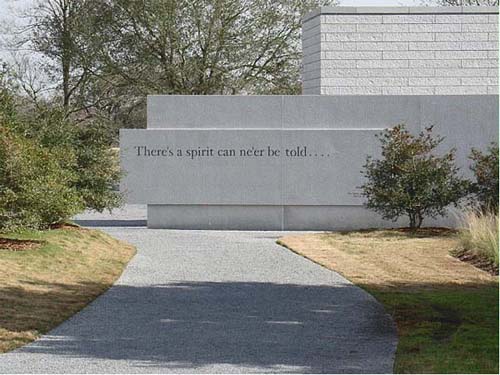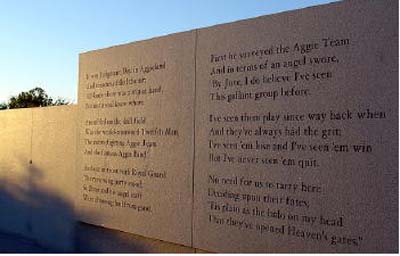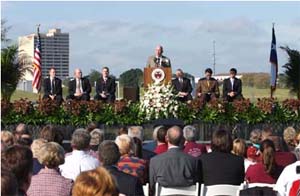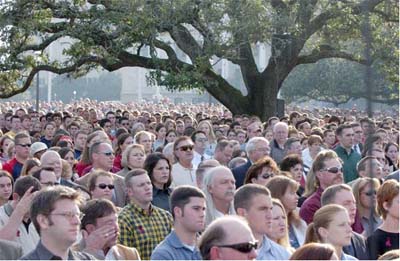The Bonfire Memorial Project
This project involved a large number of people, both on- and off-campus. Involvement began in the Fall of 2000 when the Bonfire Memorial Committee decided to develop a design for the Bonfire Memorial through a design competition. The Memorial is the only structure on campus that has ever been developed on campus in this manner. The Design Competition Office opened in January of 2001 with Dr. Chang-Shan Huang Co-director of design and creativity, and Dr. George O. Rogers Co-director of administration. The design was selected through a two-phase competition that began with nearly 200 designs, selected four semi-finalists in the first phase and selected the existing design from Overland Partners Inc., from San Antonio, Texas.
 The
Competition sought to recognize those Aggies killed and injured in
the tragic collapse of Bonfire stack on November 18, 1999. But perhaps
more
challenging, designers were asked to let their designs reflect on the
tradition of Bonfire, and the Aggie Spirit itself. The selected design
from Overland Partners took this challenge to heart. They chose to
open their design with an entry-way marked with the quote from the Spirit
of Aggieland, "There's a spirit can ne'er be told...", which
was written by Marvin Mimms (Class of '26).
The
Competition sought to recognize those Aggies killed and injured in
the tragic collapse of Bonfire stack on November 18, 1999. But perhaps
more
challenging, designers were asked to let their designs reflect on the
tradition of Bonfire, and the Aggie Spirit itself. The selected design
from Overland Partners took this challenge to heart. They chose to
open their design with an entry-way marked with the quote from the Spirit
of Aggieland, "There's a spirit can ne'er be told...", which
was written by Marvin Mimms (Class of '26).
As the visitor passes "Spirit Wall" they enter "Tradition Plaza." The central feature of Tradition Plaza is the poem by Col. Duval (Class of '45) engraved on five large granite tablets. The Last Corps Trip poem was recited just prior to the lighting of Bonfire each year. Leaving Tradition Plaza the visitor steps onto "History Walk", which is approximately 540 feet in length. Beginning with the 1909 stone that represents the first Bonfire held on campus. History Walk represents the 90 year Bonfire Tradition in terms of 89 stones with a notch representing November of each year that Bonfire burned, and a equal size gap for 1963. The Bonfire did not burn in 1963 as it was the year President Kennedy was assassinated. The Yell Leader of the day Mike Marlowe is quoted as saying "it was the most we have, and the least we can give." Out of respect Bonfire was disassembled without being burned that year. The three deaths prior to 1999, in 1955, 1982 and 1996, are depicted with a bronze plaque in the year of the death which includes the name and class year of the fallen Aggie.

 At
the end of History Walk, "Spirit Ring" depicts the Aggie Spirit with a ring, one of the most important symbols to an Aggie. This ring is 170 feet in diameter, the same size as the perimeter fence when Bonfire burned. A fence where Aggies have historically gathered to celebrate their "burning desire to be the hell out of texas",
and mourned the loss of their fellow Aggies in 1999. The circle is
comprised of 12 portals representing each of the fallen Aggies as
a gap in the
Spirit Ring that is symbolically filled by the visitor as they pass
through the portal, and 27 stones representing the known injured.
Spirit ring
is centered on the exact location of center pole 1999. At center
pole a simple marker remembers the date and time of the collapse,
and indicates
the direction of each fallen-Aggies' hometown.
At
the end of History Walk, "Spirit Ring" depicts the Aggie Spirit with a ring, one of the most important symbols to an Aggie. This ring is 170 feet in diameter, the same size as the perimeter fence when Bonfire burned. A fence where Aggies have historically gathered to celebrate their "burning desire to be the hell out of texas",
and mourned the loss of their fellow Aggies in 1999. The circle is
comprised of 12 portals representing each of the fallen Aggies as
a gap in the
Spirit Ring that is symbolically filled by the visitor as they pass
through the portal, and 27 stones representing the known injured.
Spirit ring
is centered on the exact location of center pole 1999. At center
pole a simple marker remembers the date and time of the collapse,
and indicates
the direction of each fallen-Aggies' hometown.
 Each portal is comprised of a granite portal that is 16 feet high, and a bronze portal within that is 12 feet high. On the bronze portal, each fallen Aggie is represented in the same way that people know people everywhere and Aggies know one another wherever they go--by their face, their name (and of course their class year), and their reputation.
Each portal is comprised of a granite portal that is 16 feet high, and a bronze portal within that is 12 feet high. On the bronze portal, each fallen Aggie is represented in the same way that people know people everywhere and Aggies know one another wherever they go--by their face, their name (and of course their class year), and their reputation.
The competition was guided by the same principles that guide Aggies everywhere--fairness, participation, teamwork, leadership, and respect. These principles became the guiding framework for the Bonfire project, and came to be expressed simply as Respect, Remembrance, and Spirit. In the Fall of 2003 President Gates appointed a Bonfire Memorial Dedication Committee. Dr. Wynn Rossier, Dr. George O. Rogers and the Student Body President, first Matt Josephe and later Jackson Hildebrand served as Co-Chairs, but the truth is that the Bonfire Dedication Committee worked as a team, committed to the best event possible. Hundreds of people, Aggies and non-Aggies alike worked together in the Spirit of Aggieland to assure a Memorial befitting the events of November 18, 1999 and the Bonfire Tradition. The Bonfire memorial helps us all understand how the darkest day in Aggie History, November 18, 1999, has become one our most extraordinary moments. A day when Aggies of all ages and class years experienced the Aggie Spirit in a deep and extremely personal loss. A manner so deep and so unimaginably personal that even non-Aggies could experience it and better understand the "spirit can ne'er be told."
Throughout the process efforts were made to ensure participation by the families of those killed and injured. The families generously gave of their time and energy to participate in often emotional day-long visits for construction updates and meetings on both the memorial and the upcoming dedication ceremony. While these meetings often raised and resolved conflicts, they were always conducted with mutual respect for all parties involved. The often inspirational stories of the families and their concerns helped at least one non-Aggie understand what it means to be an Aggie.

 On
the fifth anniversary of the Bonfire tragedy, November 18, 2004, the
Memorial was dedicated. Mr. Jerry Ebanks, father of Michael Ebanks
'03, talked about his son and his dedication to Texas A&M and the
tradition known among Aggies simply as Bonfire. Injured Student Chip
Thiel '03
also spoke of the meaning of the Bonfire Tradition. It was an emotional
day for many. The crowd in attendance was estimated to reach nearly
50,000.
On
the fifth anniversary of the Bonfire tragedy, November 18, 2004, the
Memorial was dedicated. Mr. Jerry Ebanks, father of Michael Ebanks
'03, talked about his son and his dedication to Texas A&M and the
tradition known among Aggies simply as Bonfire. Injured Student Chip
Thiel '03
also spoke of the meaning of the Bonfire Tradition. It was an emotional
day for many. The crowd in attendance was estimated to reach nearly
50,000.
